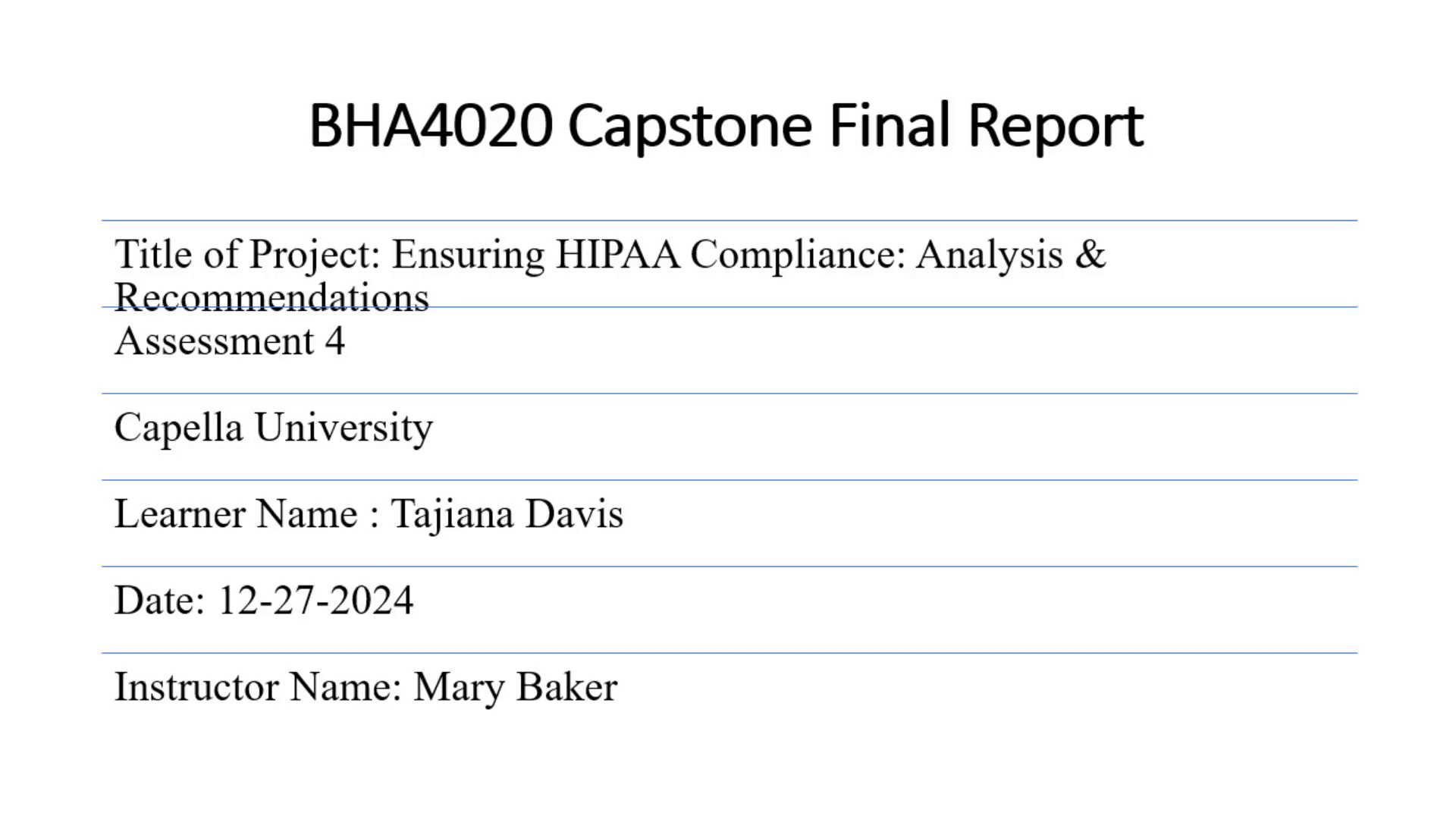
BHA4020 Capstone Final Report
Scene 1 (0s)
[Audio] BHA4020 Capstone Final Report Title of Project: Ensuring HIPAA Compliance: Analysis & Recommendations Assessment 4 Capella University Learner Name : Tajiana Davis Date: 12-27-2024 Instructor Name: Mary Baker Welcome the audience and provide a brief overview of the presentation. Highlight the significance of HIPAA compliance in the healthcare industry..
Scene 2 (33s)
[Audio] Ensuring HIPAA Compliance: Analysis & Recommendations Statement of the Problem Factors Examined & Units of Measurement Summary of Literature: Key Findings Data Presentation Data Analysis Evidence Based Recommendations Conclusion References.
Scene 3 (54s)
[Audio] Increased numbers of healthcare data breaches indicate a lack of adequate compliance. More adoption of e-Health plus records and telehealth solutions. Protect PHI from different threats. Develop strategies to mitigate privacy and security risks while ensuring compliance. Statement of the Problem Explain the growing challenges faced by healthcare organizations regarding data security. Emphasize how this problem affects patient trust and organizational reputation..
Scene 4 (1m 24s)
[Audio] Factors Examined: Frequency of audits and breaches. Implementation of audit controls. Staff training effectiveness. Technical safeguards in place. Units of Measurement: Number of reported breaches. Audit control scores. Percentage of staff completing training. System vulnerability assessment results. Factors Examined & Units of Measurement Introduce the analyzed factors and why they are crucial for HIPAA compliance. Discuss how these metrics provide measurable insights into organizational preparedness..
Scene 5 (2m 4s)
[Audio] Luoma (2016): HIPAA audits reveal common compliance gaps in encryption and access controls and the importance of encryption to protect PHI. Gaps in access control increase risks. Merrill & Groden (2017): Risk assessment is critical for compliance calibration. Encourages organizations to tailor their risk mitigation strategies. Strauss (2017): Audit controls are essential for proactive breach detection. Highlighted examples of breaches detected early through audit controls. Burns et al. (2016): Medical device security remains an emerging challenge. Emphasis on securing interconnected medical devices to prevent unauthorized access. Roemer (2017): Innovations must balance care transformation with patient privacy. Striking a balance between technological adoption and privacy safeguards. Summary of Literature: Key Findings Please provide an overview of the key findings from the literature and their practical implications. Could you highlight the importance of addressing gaps in encryption, risk assessment, and audit controls?.
Scene 6 (3m 22s)
[Audio] Data-Driven Action Plan (#1) Statistics: 60% of breaches due to human error. 40% of healthcare organizations lack robust audit controls. Charts: Bar graph: Breaches by cause (e.g., hacking, human error, device theft). Pie chart: Percentage of organizations with implemented safeguards. Discuss the statistics and their significance in identifying vulnerabilities. Explain the charts and how they illustrate the root causes and compliance gaps..
Scene 7 (3m 56s)
[Audio] Root Causes: Insufficient training and awareness. Outdated or absent security protocols. Patterns Identified: Smaller organizations are more vulnerable. Increased breaches correlate with remote work adoption. Data-Driven Action Plan (#2) Use the graphs to highlight trends and progress. Discuss the goals set for training completion and audit score improvement..
Scene 8 (4m 23s)
[Audio] 1. Enhance Staff Training: Implement mandatory annual training on HIPAA compliance. 2. Implement Robust Audit Controls: Automate the detection and reporting of breaches. 3. Strengthen Technical Safeguards: Ensure all devices storing Protected Health Information (PHI) are encrypted. 4. Conduct Regular Risk Assessments: Perform quarterly evaluations to identify compliance gaps. 5. Adopt Secure Telehealth Platforms: Ensure that virtual care systems have end-to-end encryption. Data Analysis Explain the root causes behind compliance gaps. Highlight patterns that demonstrate why certain organizations face more challenges..
Scene 9 (5m 16s)
[Audio] Evidence-Based Recommendations Enhance Staff Training: Mandatory annual HIPAA compliance training. Implement Robust Audit Controls: Automate breach detection and reporting. Strengthen Technical Safeguards: Encrypt all devices storing PHI. Conduct Regular Risk Assessments: Quarterly evaluations of compliance gaps. Adopt Secure Telehealth Platforms: Ensure end-to-end encryption for virtual care. Present the recommendations and their basis in the data and literature review. Emphasize how these actions address identified gaps and ensure sustained compliance..
Scene 10 (6m 3s)
[Audio] Rational for Execution of Recommendations Staff Training: Reduces human error, which accounts for 60% of breaches. Audit Controls: Enables early detection, limiting breach impact. Technical Safeguards: Prevents unauthorized access to PHI. Risk Assessments: Identifies vulnerabilities proactively. Secure Telehealth Platforms: Protects patient data in a growing care delivery area. Outcome: A holistic approach ensures sustained compliance and patient trust. Justify each recommendation by linking it to the data and key findings. Show how these steps collectively strengthen the compliance framework.
Scene 11 (6m 50s)
[Audio] Protecting PHI is a shared responsibility. Evidence-based strategies reduce risks and enhance trust. Ongoing compliance efforts are essential for sustainable healthcare delivery. Conclusion Summarize the main points of the presentation. Reinforce the importance of implementing the recommendations. Thank the audience and invite questions..
Scene 12 (7m 14s)
[Audio] Luoma, C. (2016). Being prepared in the age of HIPAA audits. Health Management Technology, 37(8), 24. Merrill, R. J., & Groden, S. L. (2017). A due diligence "to do": Evaluate privacy and security compliance. Journal of Health Care Compliance, 19(3), 5–14. Strauss, L. J. (2017). The value of auditing and audit controls. Journal of Health Care Compliance, 19(5), 43–53. Burns, A. J., Johnson, M. E., & Honeyman, P. (2016). A brief chronology of medical device security. Communications of the ACM, 59(10), 66–72. Roemer, K. (2017). Innovations for healthcare that ensure patient privacy. Health Management Technology, 38(10), 10. References Acknowledge the sources used for this analysis. Highlight the relevance of these references to the presentation content..